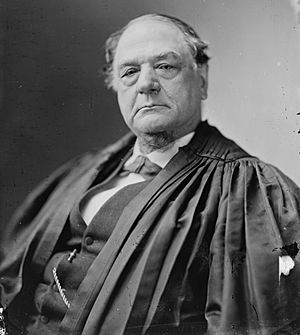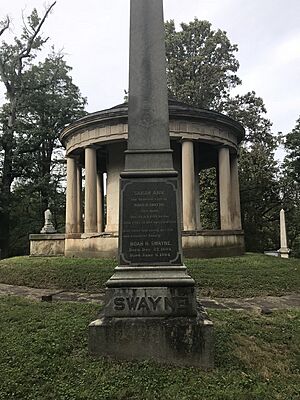Noah Haynes Swayne facts for kids
Quick facts for kids
Noah Haynes Swayne
|
|
|---|---|
 |
|
| Associate Justice of the Supreme Court of the United States | |
| In office January 27, 1862 – January 24, 1881 |
|
| Nominated by | Abraham Lincoln |
| Preceded by | John McLean |
| Succeeded by | Stanley Matthews |
| Personal details | |
| Born | December 7, 1804 Frederick County, Virginia, U.S. |
| Died | June 8, 1884 (aged 79) New York City, New York, U.S. |
| Political party | Democratic (Before 1856) Republican (1856–1884) |
| Spouse | Sarah Swayne |
| Signature | |
Noah Haynes Swayne (born December 7, 1804 – died June 8, 1884) was an important American judge and politician. He made history as the first member of the Republican Party to be chosen as a justice for the U.S. Supreme Court.
Contents
Early Life and Education
Noah Haynes Swayne was born on December 7, 1804, in Frederick County, Virginia. He grew up in the beautiful Shenandoah Valley, about 100 miles (160 km) northwest of Washington D.C. He was the youngest of nine children. His family had come from England in 1710.
After his father passed away in 1809, Noah continued his schooling locally. From 1817 to 1818, he attended Jacob Mendendhall's Academy in Waterford, Virginia, a respected Quaker school. He briefly studied medicine but stopped when his teacher died.
Even though his family didn't have money for more schooling, Noah was determined. He studied law on his own with two lawyers in Warrenton, Virginia. In 1823, he passed the exam to become a lawyer in Virginia.
Moving to Ohio and Fighting Slavery
Swayne was a devoted Quaker, and he strongly disagreed with slavery. In fact, he is the only Quaker ever to serve on the Supreme Court. Because of his strong abolitionist beliefs, he left Virginia in 1824 and moved to Ohio, which was a free state where slavery was not allowed.
He started his own law practice in Coshocton, Ohio. In 1825, he was elected as the county attorney for Coshocton County, Ohio. Four years later, he was elected to the Ohio state legislature.
In 1830, President Andrew Jackson appointed Swayne as the U.S. Attorney for Ohio. This meant he was the chief lawyer for the federal government in the state. He then moved to Columbus, Ohio, for this new job.
Political Career and Friendships
While working as the U.S. Attorney, Swayne also got involved in local politics. He was elected to the Columbus City Council in 1834 and the Ohio House of Representatives in 1836.
During this time, Swayne became good friends with John McLean, who was a justice on the U.S. Supreme Court. McLean later became a strong Republican. When the Republican Party was formed in 1855, Swayne was one of its first members and helped organize the party.
In 1835, there was a dispute between Ohio and the Michigan Territory over their border, known as the Toledo War. It almost led to fighting. Ohio Governor Robert Lucas sent Swayne and two other men to Washington D.C. to talk with President Andrew Jackson. They explained Ohio's side and asked the President to help solve the problem quickly.
Serving on the Supreme Court
Justice John McLean, Swayne's friend, was one of two judges who disagreed with the famous Dred Scott decision, which said that African Americans could not be citizens. McLean tried to become the Republican candidate for President in 1860 but lost to Abraham Lincoln. However, he often suggested to Lincoln that Swayne should replace him on the Supreme Court when he retired.
This suggestion became important when McLean died in April 1861, soon after Lincoln became President. As the American Civil War was beginning, Swayne worked hard to get the vacant Supreme Court seat. He asked several members of Congress from Ohio for their support.
Swayne fit what President Lincoln was looking for in a judge: he was loyal to the Union, he was against slavery, and he was from the right part of the country (Ohio). It is also believed that Swayne had helped enslaved people who had escaped by representing them in court.
So, nine months after McLean's death, President Lincoln nominated Swayne on January 21, 1862. The United States Senate approved his nomination on January 24, 1862. Three days later, on January 27, he officially became the 35th justice of the Supreme Court.
Important Court Decisions
One important case Swayne worked on was United States v. Rhodes in 1867. In this case, he supported the Civil Rights Act of 1866, which aimed to protect the rights of newly freed enslaved people. He wrote that simply ending slavery would not be enough if states could still oppress former slaves. He believed the law was necessary to truly give freedom and prevent slavery from returning in a different form.
Swayne was one of the justices who disagreed with the majority in the Slaughter-House Cases in 1873. This case was very important for understanding the Fourteenth Amendment, which was new at the time and gave rights to all citizens. Later, however, Swayne joined the majority in Munn v. Illinois, another key case about government regulation.
Swayne was the first of five judges President Lincoln appointed to the Supreme Court. The others were Samuel Freeman Miller, David Davis, Stephen Johnson Field, and Salmon P. Chase (who became Chief Justice). Swayne was known for strongly supporting President Lincoln's actions during the Civil War, such as the Union blockade and the use of paper money.
He is most famous for his opinion in Springer v. United States (1881), which upheld the federal income tax that was put in place during the Civil War.
In Gelpcke v. City of Dubuque (1864), Swayne wrote the main opinion. He said that contracts made based on earlier court decisions could not be changed by new laws. He believed that justice and law should not be sacrificed just because a state court decided to change things. This showed his strong support for the rights of people who held railroad bonds, even when states tried to cancel those agreements.
Swayne stayed on the court until 1881. He tried twice to become the Chief Justice (after Roger Taney died in 1864 and Salmon P. Chase died in 1873), but he was not chosen.
Retirement and Legacy
Noah Swayne is not considered one of the most famous Supreme Court justices. He didn't write many opinions himself, often agreeing with what other judges wrote. He stayed on the court even when he was quite ill.
Under pressure from President Rutherford B. Hayes, Swayne finally agreed to retire in 1881. He did so on one condition: that his friend and fellow Ohio lawyer, Stanley Matthews, would replace him.
Swayne's son, Wager Swayne, was a Major General in the American Civil War. After the war, he served as the military governor of Alabama. He later started law firms in Ohio and New York City. Wager's son, Noah Hayes Swayne (named after his grandfather), became president of a large coal distribution company. Another of Wager's sons, Alfred Harris Swayne, was a vice president at General Motors Corporation.
Another of Justice Swayne's sons, also named Noah Swayne, was a lawyer in Toledo, Ohio. He donated the land for Swayne Field, which used to be the home baseball field for the Toledo Mud Hens team.
Justice Swayne passed away in 1884. He is buried at the Oak Hill Cemetery in Washington, D.C. Other important figures, like Chief Justice Edward Douglass White, are also buried there.
Some of Swayne's legal papers from before he became a justice are kept at the Ohio History Connection. Letters he exchanged with others can also be found in various collections.
See also
- List of federal judges appointed by Abraham Lincoln
- Nomination and confirmation to the Supreme Court of the United States
- List of justices of the Supreme Court of the United States
- Chase Court
- Taney Court
- Waite Court


